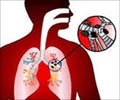How Does Smoking Lead to Cancer?
Tobacco smoke contains about 70 carcinogenic (cancer causing) substances. Some of these harmful substances are - carbon monoxide, tar, arsenic, cyanide, benzene, formaldehyde, methanol, acetylene, ammonia, lead etc.
The cancer-causing agents (carcinogens) in tobacco smoke enter the lungs on inhalation. From there they spread to the rest of the body and damage important genes. They mutate the DNA that controls the growth of cells, causing them to grow abnormally or to reproduce in a haphazard manner. The carcinogen carbon monoxide binds to hemoglobin in red blood cells. This prevents the affected RBCs from carrying a full load of oxygen. The carcinogen benzo[a]pyrene binds to cells in the airways and major organs of smokers. Smokers have lower levels of antioxidants in their blood, which prevents the damaged cells from repairing themselves. Smoking affects the function of the immune system and may increase the risk for respiratory and other infections.












